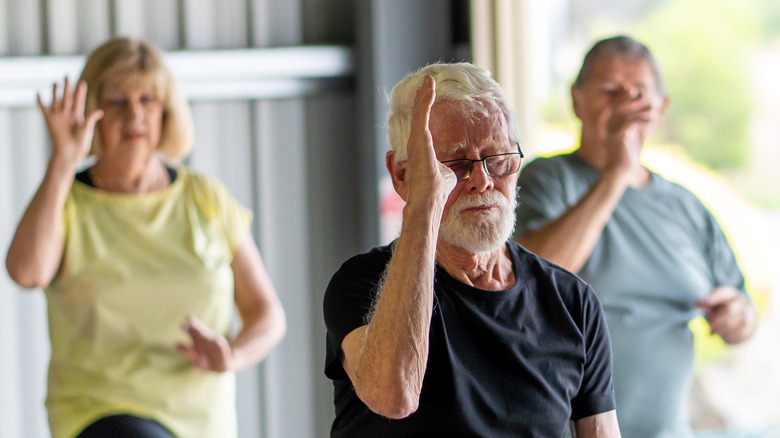Here's Why Active Recovery Is So Important To Your Workout Regimen
The world of fitness is tough, which is why people and brands alike come up with all sorts of catchy mantras to keep exercisers motivated. Not only do marketing slogans like "sore today, strong tomorrow" remind people to take workouts seriously, but they also make fitness sound like it's out of your reach until you're out of your breath. That's inaccurate at best. Placing unreasonable demands on yourself and exercising beyond your limits without sufficient recovery time can take a great toll on your health. "You should be able to get in a gym session — in and out — in 45 to 75 minutes max," says Muscle Model champion and transformation trainer Micah LaCerte (via Men's Journal). A workout session doesn't always have to be grueling, ending with muscle soreness, trembling feet, and sweat oozing out of your every pore. If going full speed and going to sleep are all that you do during and after a workout session, you're missing out on a very important element of your fitness regimen: active recovery.
Active recovery, according to Healthline, refers to low-intensity exercise that you can engage in after a strenuous workout session to speed up your recovery and maintain your athletic performance. This may sound like a contradiction, but being active is also a part of recovery, alongside being passive. In fact, active recovery can bring you more benefits than passive recovery. Here's why.
Active recovery helps your muscles recover after a grueling workout
After a high-intensity workout, resist the urge to lay down, snack, or do nothing. Instead, you can spend six to 10 minutes performing low-intensity moves at your own pace to gradually reduce a sense of heaviness and discomfort in your muscles. Examples include stretching or cycling between sessions, immediately after a strenuous exercise, or on your off days. Aside from helping you regulate various physiological processes to keep your inner body balanced, per blog NASM, active recovery is better than passive recovery, which is inactivity.
According to Healthline, active recovery can boost blood flow, decrease lactic acid accumulation in the muscles, eliminate metabolic waste, and minimize muscle pain. The key to finding an active recovery exercise with the right level of intensity for you is to use the talk-test. For instance, if you can engage in an activity, such as jogging or cycling, while talking, it's probably the ideal workout for you.
Active recovery exercises you can try
When it comes to activities that help your muscles recuperate, use movement patterns that "provide some conditioning without taxing the body too much," says NASM-certified personal trainer Allison Tibbs to Shape. For example, if you're planning an active recovery day between exercise days, refresh your mind with some low-impact exercises such as tai chi, yoga, and light-resistance training. Characterized by slow and steady movements aimed at improving balance, tai chi is a gentle exercise to combat the stress from our high-strung workouts and daily lives. According to a study in the Journal of Rheumatology, tai chi can aid in reducing pain and stiffness among exercisers with arthritis. If you want to be in motion while in meditation, tai chi makes a great option. Yoga, a mind-body exercise made up of many stretching poses and breathwork, can also relieve the muscle groups exhausted from your previous workout. Foam rolling, a method of tenderly massaging yourself to enhance blood circulation and eliminate toxins accumulated during exercise, also boosts quicker recuperation time.
No matter how ambitious your fitness goals are, you should set aside time for active recovery to let your muscles heal. Otherwise, you may have a hard time consistently arriving at the gym in good spirits. In short, active recovery helps you rejuvenate physically and mentally while also enhancing your sports performance.


